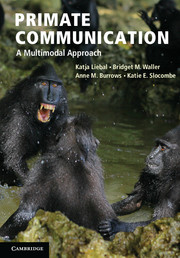Book contents
- Frontmatter
- Contents
- Preface
- Acknowledgements
- Part I Introduction to primate communication
- 1 What is primate communication?
- 2 The morphology of primate communication
- 3 The neural substrates of primate communication
- Part II Approaches to primate communication
- Part III Cognitive characteristics of primate communication
- Part IV Approaches to the evolution of primate communication
- Glossary
- References
- Species index
- Subject index
3 - The neural substrates of primate communication
Published online by Cambridge University Press: 05 December 2013
- Frontmatter
- Contents
- Preface
- Acknowledgements
- Part I Introduction to primate communication
- 1 What is primate communication?
- 2 The morphology of primate communication
- 3 The neural substrates of primate communication
- Part II Approaches to primate communication
- Part III Cognitive characteristics of primate communication
- Part IV Approaches to the evolution of primate communication
- Glossary
- References
- Species index
- Subject index
Summary
Primates – like any animate being – receive different kinds of sensory input from their environment mediated, amongst others, by olfactory, visual and auditory channels. The processing of these very different kinds of information is mediated by the nervous system. In primates and other vertebrates, it is comprised of two major parts, the central and the peripheral nervous system. The central nervous system consists of the brain and the spinal cord, and is responsible for integrating the sensory information it receives from the body and selecting an appropriate motor response, thus coordinating the corresponding actions. The peripheral nervous system connects the central nervous system with the body. It relays sensory information from the body to the central nervous system and carries nerve impulses from the central nervous system to different body parts, such as limbs or organs.
The focus of this chapter is on those areas of the brain that are specifically involved in the perception and production of communicative signals. First, a brief section will introduce the major parts of the primate brain and will highlight those features that differentiate primates from other mammals with special reference to the structures that are unique to the human brain. Second, the corresponding brain areas involved in the production and perception of signals will be presented separately for each modality, and with special emphasis on differences among species. Third, a final section will focus on those brain areas that are responsible for the integration of multiple sources of sensory information to emphasize the multimodal nature of primate communication at a neural level.
- Type
- Chapter
- Information
- Primate CommunicationA Multimodal Approach, pp. 46 - 70Publisher: Cambridge University PressPrint publication year: 2013

